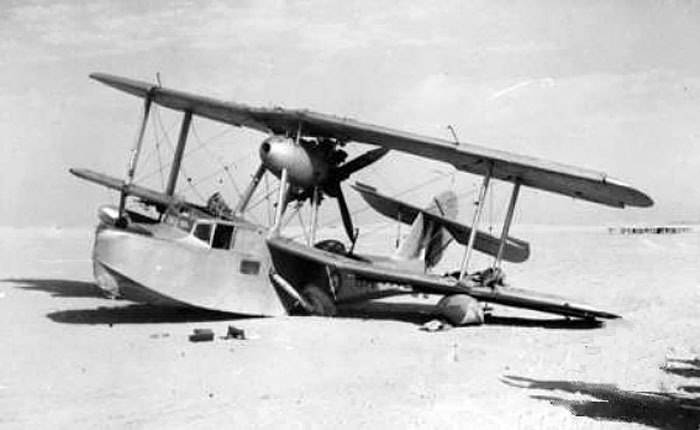- Yes
- No
Supermarine Walrus Mk.I

Design and service history:
The Supermarine Walrus should be nothing new to naval players who have dabbled in HMS York, as it serves as that vessel’s floatplane. For those who have not experienced the mid-tier of the British naval line, the Supermarine Walrus is a single-engine amphibious biplane that was primarily used as a maritime patrol aircraft, with a service too long to mention in a suggestion without it turning into a full-blown essay. The Walrus is of note, for being the first amphibious aircraft in British service with a fully retractable undercarriage, along with a fully enclosed crew compartment and all-metal fuselage.
The Walrus started life as a private venture, looking to secure a contract with Australia for a catapult aircraft for their cruisers at the time. The initial trials were successful, and an order of 24 aircraft were made to the RAAF under the name Seagull V, indicating the planes’ direct lineage from the earlier Seagull aircraft. The RAF would follow suit with their own orders, and the type under the name Walrus Mk.I would begin deliveries in 1936, and it would serve in both the RAF and the FAA during its life.
Early examples provided before 1936 were named the Supermarine Seagull V, but this was soon changed to the Walrus, as it was deemed a far enough departure from the Seagull IV to justify the new name designation. During service, the Walrus would serve as a fleet spotter launched by catapult by both cruisers and battleships of the Royal Navy, guaranteeing its service in all oceans during the Second World War. In addition to this spotting role, it could also be employed as a maritime patrol aircraft, flying lifeboat ( walruses saved over 1000 downed airmen during the Second World War), light bomber (The Walrus was fitted with a bombsight and a respectable bomb capacity), Transport, Liason aircraft and anti submarine warfare aircraft, giving it a large range of roles despite its ungainly appearance.
The design choice to switch from a wooden hull to a metal one was intended to grant greater longevity in tropical conditions. This, in combination with the aircraft’s single 750 hp Bristol Pegasus VI and a respectable amount of fuel, gave the Walrus a range of 600 miles, giving it both a good loiter time and operational capacity. In terms of armament, the Aircraft possessed 3 Vickers go guns, one mounted fore, on a ring mount, and a double gun configuration in the aft gunner’s position. This was supplemented by a respectable bomb payload with common configurations being 2 x 250lb and 6 x 100lb loadouts, allowing the aircraft to strike targets in land, like what occurred in North Africa.
In total 555 walrus one’s were manufactured between 1936 and 1944, with the tooling for the successful design fending off the contending replacement the Supermarine Sea Otter, a much improved design. The reason for this was that during 1936 it became apparent that Supermarine’s main factory lacked the capacity to fulfil its order for an additional 168 Walruses whilst also manufacturing 310 spitfire’s that had been ordered the previous June. Due to this, production was subcontracted to Saunders-Roe, a company famous for their own flying boat designs. This change resulted in a factory continuing to make parts and aircraft for an outdated design, very similarly to what occurred with the Fairey Swordfish and Blackburn. In total 285 Walrus’s were manufactured by Supermarine and 270 by Saunders-Roe, with the Saunder’s made mark I’s often being called Mark II’s though this is a different aircraft for another suggestion.
This large number of Walruses would serve in the RAAF, FAA,RAF, RNZN, RNZAF, RAF Search and Rescue Force and a wide number of export nations, civil and military. The walrus was intended to be replaced by the Sea Otter, but sheer numbers prevented this from occurring, with the Walrus serving until 1946 with the RAF and trekking on to 1956 with the Royal Navy, marking the end of a long and capable career, for what otherwise from a glance appears to be an aircraft stuck in the early 30s.
Vehicle Specification:
General characteristics
Crew: 3
Length: 37 ft 7 in (11.46 m) on wheels
Wingspan: 45 ft 10 in (13.97 m)
Height: 15 ft 3 in (4.65 m) on wheels
Wing area: 610 sq ft (57 m2)
Empty weight: 4,900 lb (2,223 kg)
Gross weight: 7,200 lb (3,266 kg)
Max takeoff weight: 8,050 lb (3,651 kg)
Powerplant: 1 × Bristol Pegasus VI 9-cylinder air-cooled radial piston engine, 750 hp (560 kW)
Propellers: 4-bladed wooden fixed-pitch pusher propeller
Performance
Maximum speed: 135 mph (217 km/h, 117 kn) at 4,750 ft (1,448 m)
Cruise speed: 92 mph (148 km/h, 80 kn) * Alighting speed: 57 mph (50 kn; 92 km/h)
Range: 600 mi (970 km, 520 nmi) at cruise
Service ceiling: 18,500 ft (5,600 m)
Rate of climb: 1,050 ft/min (5.3 m/s)
Time to altitude: 10,000 ft (3,000 m) in 12 minutes 30 seconds
Wing loading: 11.8 lb/sq ft (58 kg/m2)
Power/mass: 0.094 hp/lb (0.155 kW/kg)
Armament
Guns: 3 × .303 in (7.7 mm) Vickers G.O. machine guns (one in nose, two in aft turret)
Bombs:
6 × 100 lb (45 kg) bombs
2 × 250 lb (110 kg) bombs
2 × 250 lb (110 kg) Mk.VIII depth charges
or any of the other presets outlined here from figure 127A from the full aircraft manual PDF linked in the sources below:


Historical photos:
Photo showing layout for the twin turret mounted in the rear of the Walrus, an armament that was standard in late 1943, taken from manual in source:

Additional photos:











Sources:
- Supermarine Walrus (History of type)
- https://www.seawings.co.uk/images/manuals/Walrus%20Manual/Supermarine%20Walrus%20Mk.I%20&%20II%20Manual-(Redu-v5).pdf (Full manual pdf for aircraft)
- Supermarine Walrus - Wikipedia (Wikipage for the type)
- Supermarine Walrus (More history)
- https://pacificeagles.net/supermarine-walrus/ (more history/spec)

